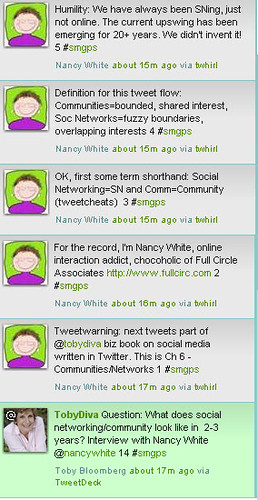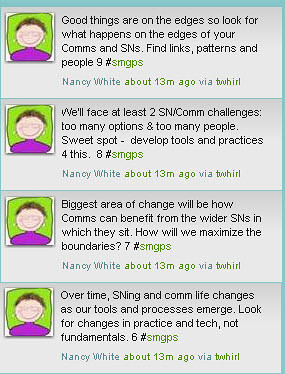 Toby Bloomberg is not the type to let the dust gather. She is always looking at things, asking “what can we do with that” and, rather than just asking, she starts trying and doing. She is a force to be reckoned with!
Toby Bloomberg is not the type to let the dust gather. She is always looking at things, asking “what can we do with that” and, rather than just asking, she starts trying and doing. She is a force to be reckoned with!
She is at it again with her latest experiment, Social Media Marketing GSP: A Tweet-book. She asked me to be one of her guinea pigs… um… I mean interviewees… for chapter 6 on communities and networks. Of course, I had to say yes. Here is a bit of context. My tweets are embedded. Let’s see if this makes any sense!
So what’s a Twitter-book you may be asking? It’s a book written using Twitter as platform and distribution channel. Social Media Marketing GPS #smgps is the first business book to experiment with this format.
This Twitter-book is structured as a “real” business book and includes: a foreword, introduction and chapters. Each chapter will have a 1 question interview with people knowledgeable about the topic. All posts will be hash-tagged #smgps.
Chapters and interviews will be tweeted Monday – Friday through the end of April. I invite you to join me in this experiment in a new way to write a business book. Please add your insights and learnings to the stream; they’ll be incorporated into the book. My ultimate goal is that this Twitter-book will serve as a resource about social media written by and for marketers. So explore .. have fun .. discover and don’t be afraid to try it out.
 Now that Toby is on chapter six, she has sussed out the process a bit and suggested earlier in the week that preparation is worth it, and that trying to not get carried away with too many tweets is also useful. That asks the writer to be both succinct per post (140 characters) and overall. With the size of the question Toby asked me, that was challenging. How to be brief but substantive, eh? It is harder than it looks.
Now that Toby is on chapter six, she has sussed out the process a bit and suggested earlier in the week that preparation is worth it, and that trying to not get carried away with too many tweets is also useful. That asks the writer to be both succinct per post (140 characters) and overall. With the size of the question Toby asked me, that was challenging. How to be brief but substantive, eh? It is harder than it looks.
It is also interesting to try and express something that both works read forwards and backwards. Readers reading back on Twitter, get it from tail to head. Those reading the recap on the blog and eventually the “book” (whatever form that might take) get it in order. Tricky. Interesting.
As I tweeted out my 12 140 character or less contributions, a few people wondered if I a) should be writing a blog post instead (they missed the context and Toby’s intro, I suppose) b) had too much nervous energy and c) how they might contribute. I think the burst of volume might not have been appreciated by all those people following me.
Hmmmm… what do you think?  Are we pushing a medium too far or is this a useful, creative application? Or something all together different?
Are we pushing a medium too far or is this a useful, creative application? Or something all together different?
Here are a few other creative writing experiments with Twitter:
- http://www.140characters.com/
- TwitterPoems (apropos for National Poetry month)
- Twitter Magnets
The interview for Chapter 6 is also now up here.
 Throughout the year I’m involved in quite a few conferences and meetings. This year, the ground is shifting. Travel budgets are being slashed (faster here than in Europe as far as I can tell) and people are starting to think more seriously about the non financial costs such as carbon emissions of the travel and the plain old wear and tear on our bodies traveling across time zones and geography.
Throughout the year I’m involved in quite a few conferences and meetings. This year, the ground is shifting. Travel budgets are being slashed (faster here than in Europe as far as I can tell) and people are starting to think more seriously about the non financial costs such as carbon emissions of the travel and the plain old wear and tear on our bodies traveling across time zones and geography. It seems every conversation I have with someone here or overseas starts with some comment about “these times we are in.” Moreso for my US colleagues, but the change in economic times is on everyone’s mind. I’m doing more work online and less on the road. Budgets for current projects are sticking pretty steady, but no one seems to know what tomorrow will bring. For us independents, this uncertainty is nothing new, but clearly the playing field has changed.
It seems every conversation I have with someone here or overseas starts with some comment about “these times we are in.” Moreso for my US colleagues, but the change in economic times is on everyone’s mind. I’m doing more work online and less on the road. Budgets for current projects are sticking pretty steady, but no one seems to know what tomorrow will bring. For us independents, this uncertainty is nothing new, but clearly the playing field has changed.

